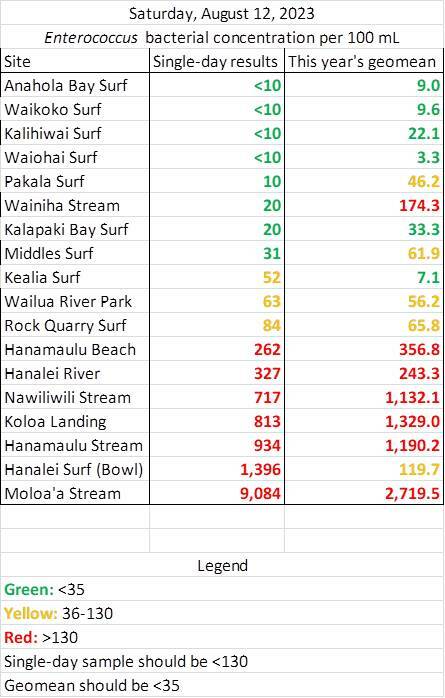Kaua‘i’s rivers, streams polluted despite dry season
LIHU‘E — On Kaua‘i, three things are certain — death, taxes, and dirty rivers.
Every month, Surfrider Kaua‘i’s Blue Water Task Force analyzes samples of streams, rivers and surf spots across the island to check for the enterococcus bacterium, a federally recognized indicator of fecal presence in water.
While much of the island’s waters have stayed relatively clean due in part to the dry summer season, nearly every river and stream tested showed single-day enterococcus levels below state water quality standards.
“Average stream counts were lower than usual, but still way too high,” said Surfrider Kaua‘i senior scientist Carl Berg. “Nawiliwili Stream had bacteria counts 5.5 times the statistician threshold value (STV, or Hawai‘i’s single-day standard), Waikomo Stream at Koloa Landing had six times the STV, Hanama‘ulu Stream was seven times the STV — but Moloa‘a had the whopper at 75 times the STV. All these streams are chronically polluted and had tested positive for human waste in the past.”
The only stream to test within state standards, Wainiha Stream, shouldn’t necessarily be considered clean, however. Its year-to-date geomean — essentially the site’s average bacterial concentration in 2023 — indicates pollution nearly five times higher than the state standard.
Berg emphasized that while single-day results can vary significantly, the geomean provides a more accurate representation of how polluted a site usually is.
“The important part is when you look at it on a broader picture, for one year or five years or 10 years, which of these areas are clean and which of them are not clean,” Berg said. “The geomean values that we’re giving you, tell you what the average condition of that location is.”
Unfortunately for Kaua‘i, the task force’s geomean values don’t tell much better of a story. With the exception of Hanalei Bowl surf spot, every site with single-day enterococcus values exceeding state standards also show excessive year-to-date values.
Only six sites (Waiohai, Kealia, Anahola Bay, Waikoko, Kalihiwai and Kalapaki Bay Surfs) currently have year-to-date geomeans within state standards, suggesting a nearly islandwide contamination problem.
Compounding Surfrider’s concerns is a study released this year by Berg finding sucralose — an artificial sweetener commonly found in manufactured foods — in nearly every corner of Kaua‘i, strongly indicating that human sewage has entered the majority of the island’s waters.
Of the 24 waters tested, all but five sites (Lumahai, Limahuli and Waikoko streams, and Hanapepe and Waimea rivers) came up positive for the presence of sucralose. Because the sweetener does not occur naturally, and because it’s largely left intact as it exits the human body, the researchers argued its presence across Kaua‘i leaves little doubt as to what’s causing the pollution.
“It’s coming from the cesspools,” Berg said following the report’s release. “We’ve been saying this all along.”
Kaua‘i’s approximately 14,000 cesspools release untreated wastewater into the ground, contaminating the island’s groundwater. Over time, this groundwater seeps into streams and rivers before dissipating as reaches nearshore waters.
In an attempt to limit this pollution, the state Legislature in 2017 passed Act 125, requiring all 88,000 of the state’s cesspools to be replaced by 2050. However, the high price of septic tank conversions — typically costing tens of thousands of dollars — has slowed these efforts.
Following the report’s release, Berg has suggested that state law should require the Hawai‘i Department of Health to post warning signs at locations where human sewage has been identified as contributing to the enterococci count, i.e., the sites where sucralose samples were acquired.
However, the department’s Clean Water Branch (CWB) has argued that it cannot currently make use of the report’s findings to influence its contamination response, citing federal procedure.
“The method used by the authors seems compelling for routine monitoring for the detection of cesspool contaminated waters; however, CWB can only use methods approved by the U.S. Environmental Protection Agency,” said CWB engineering supervisor Darryl Lum following the report’s release. “The CWB encourages the authors to submit the study for approval through EPA’s Alternative Test Procedures program under 40 CRF 136.4.”
“The CWB agrees that cesspools pose a problem in that they can potentially impact human health, as well as the aquatic life in Hawai‘i’s waters, and should be converted as soon as possible,” Lum added.
•••
Jackson Healy, reporter, can be reached at 808-647-4966 or jhealy@thegardenisland.com.


And our part should be…?
Nit picky and make sure there are no ice cream at McDonald’s. I don’t eat ice cream anyway. Too fattening. I guess call your local politics hotline. What’s happening?
Of all the years I’ve been reading TGI news, I never thought I’d would find a reporter also who is in line for doing the work of a politician. If you are doing the work, you’re getting paid more.
Wow….
What ever it is that TGI is doing, Surfrider foundation, coco palms hotel, Wailua bridge, Hanalei bridge, all these project are TGI. That’s your work. Your money. Supporting TGI any way I can. Happy for TGI.